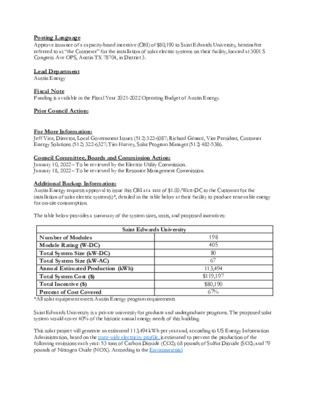Item 4: RCA- St. Edwards University — original pdf
Backup

..D e Posting Language ..T itle Approve issuance of a capacity-based incentive (CBI) of $80,190 to Saint Edwards University, hereinafter referred to as “the Customer” for the installation of solar electric systems on their facility, located at 3001 S Congress Ave OPS, Austin TX 78704, in District 3. Lead Department Austin Energy Fiscal Note Funding is available in the Fiscal Year 2021-2022 Operating Budget of Austin Energy. Prior Council Action: For More Information: Jeff Vice, Director, Local Government Issues (512) 322-6087; Richard Génecé, Vice President, Customer Energy Solutions (512) 322-6327; Tim Harvey, Solar Program Manager (512) 482-5386. Council Committee, Boards and Commission Action: January 10, 2022 – To be reviewed by the Electric Utility Commission. January 18, 2022 – To be reviewed by the Resource Management Commission. Additional Backup Information: Austin Energy requests approval to issue this CBI at a rate of $1.00/Watt-DC to the Customer for the installation of solar electric system(s)*, detailed in the table below at their facility to produce renewable energy for on-site consumption. The table below provides a summary of the system sizes, costs, and proposed incentives: Saint Edwards University Number of Modules Module Rating (W-DC) Total System Size (kW-DC) Total System Size (kW-AC) Annual Estimated Production (kWh) Total System Cost ($) Total Incentive ($) Percent of Cost Covered 198 405 80 67 113,494 $119,197 $80,190 67% *All solar equipment meets Austin Energy program requirements Saint Edwards University is a private university for graduate and undergraduate programs. The proposed solar system would cover 40% of the historic annual energy needs of this building. This solar project will generate an estimated 113,494 kWh per year and, according to US Energy Information Administration, based on the state-wide electricity profile, is estimated to prevent the production of the following emissions each year: 53 tons of Carbon Dioxide (CO2); 68 pounds of Sulfur Dioxide (SO2); and 79 pounds of Nitrogen Oxide (NOX). According to the Environmental Protection Agency (EPA)’s Greenhouse Gas Equivalency Calculator, these emissions reductions are equivalent to planting 795 trees or 58.9 acres of forest in Austin's parks or the removal of 120,837 vehicle miles or 10.5 cars from Austin roadways. According to the updated Austin Energy Resource, Generation and Climate Protection Plan, approved by Austin City Council in March 2020, “Austin Energy will achieve a total of 375 MW of local solar capacity by the end of 2030, of which 200 MW will be customer-sited (when including both in-front-of-meter and behind-the meter installations).” In order to meet these goals, Austin Energy has funded the Solar Photovoltaic (PV) Programs, which are designed to reduce the amount of electricity Austin Energy must purchase from the market and reduce associated greenhouse gas emissions. The purpose of the Austin Energy Solar PV CBI Program is to expand adoption of solar by nonprofit organizations by helping to offset the capital investment for customers who are unable to benefit from the federal tax credit. Under this program, customers who qualify as nonprofit entities (outlined in Section V.B.iv of the program guidelines), are eligible to receive $1.00/W-DC up to $482,000. Per program guidelines, the installation is expected to continue producing for a minimum of 20 years or may be subject to repay the incentive at a pro-rated amount, if it stops producing for any reason short of the stated minimum. This project will advance the stated goals of expanding locally-sited solar, carbon reduction and resiliency, extend the adoption of solar to entities historically excluded from the investment benefits of solar, and continue to demonstrate the value and importance of renewables as part of the individual and collective generation portfolio in Austin Energy territory. Strategic Outcome(s): Government That Works for All. ..S tra te g ic O u tc o m e (s)